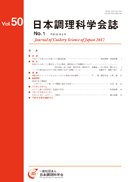Volume 50, Issue 6
Displaying 1-11 of 11 articles from this issue
- |<
- <
- 1
- >
- >|
Review
-
2017Volume 50Issue 6 Pages 217-221
Published: 2017
Released on J-STAGE: December 21, 2017
Download PDF (1083K)
Original paper
-
2017Volume 50Issue 6 Pages 222-227
Published: 2017
Released on J-STAGE: December 21, 2017
Download PDF (1227K) -
2017Volume 50Issue 6 Pages 228-238
Published: 2017
Released on J-STAGE: December 21, 2017
Download PDF (1460K)
Note
-
2017Volume 50Issue 6 Pages 239-244
Published: 2017
Released on J-STAGE: December 21, 2017
Download PDF (969K)
Technical report
-
2017Volume 50Issue 6 Pages 245-253
Published: 2017
Released on J-STAGE: December 21, 2017
Download PDF (1116K) -
2017Volume 50Issue 6 Pages 254-263
Published: 2017
Released on J-STAGE: December 21, 2017
Download PDF (1439K) -
2017Volume 50Issue 6 Pages 264-271
Published: 2017
Released on J-STAGE: December 21, 2017
Download PDF (1137K)
Course text
-
2017Volume 50Issue 6 Pages 272-276
Published: 2017
Released on J-STAGE: December 21, 2017
Download PDF (893K)
Educational materials research
-
2017Volume 50Issue 6 Pages 277-279
Published: 2017
Released on J-STAGE: December 21, 2017
Download PDF (843K)
Cooking room
-
2017Volume 50Issue 6 Pages 280-282
Published: 2017
Released on J-STAGE: December 21, 2017
Download PDF (992K)
Topics & opinion
-
2017Volume 50Issue 6 Pages 283-284
Published: 2017
Released on J-STAGE: December 21, 2017
Download PDF (722K)
- |<
- <
- 1
- >
- >|
